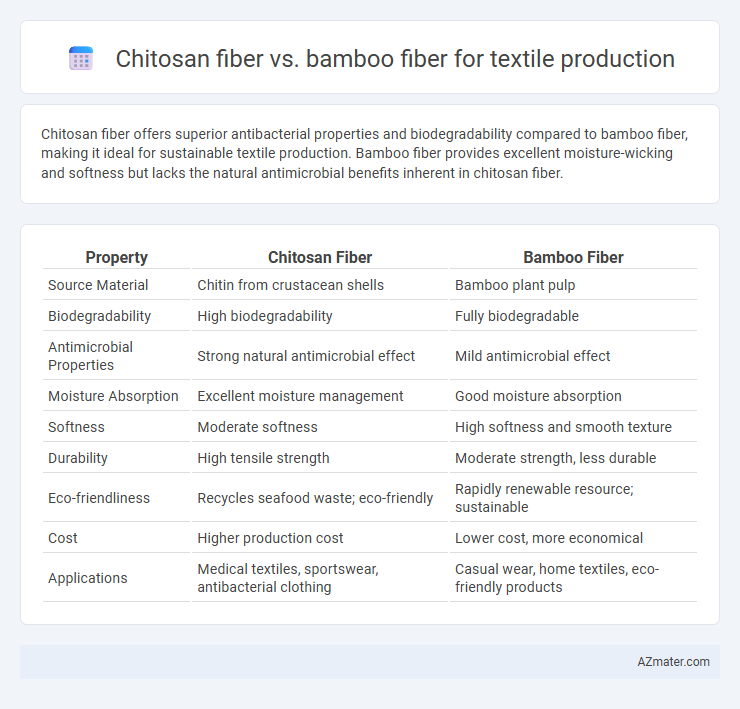Chitosan fiber offers superior antibacterial properties and biodegradability compared to bamboo fiber, making it ideal for sustainable textile production. Bamboo fiber provides excellent moisture-wicking and softness but lacks the natural antimicrobial benefits inherent in chitosan fiber.
Table of Comparison
| Property | Chitosan Fiber | Bamboo Fiber |
|---|---|---|
| Source Material | Chitin from crustacean shells | Bamboo plant pulp |
| Biodegradability | High biodegradability | Fully biodegradable |
| Antimicrobial Properties | Strong natural antimicrobial effect | Mild antimicrobial effect |
| Moisture Absorption | Excellent moisture management | Good moisture absorption |
| Softness | Moderate softness | High softness and smooth texture |
| Durability | High tensile strength | Moderate strength, less durable |
| Eco-friendliness | Recycles seafood waste; eco-friendly | Rapidly renewable resource; sustainable |
| Cost | Higher production cost | Lower cost, more economical |
| Applications | Medical textiles, sportswear, antibacterial clothing | Casual wear, home textiles, eco-friendly products |
Introduction to Chitosan and Bamboo Fibers
Chitosan fiber, derived from chitin found in crustacean shells, offers excellent biodegradability, antimicrobial properties, and moisture management, making it highly suitable for advanced textile applications. Bamboo fiber, extracted from bamboo pulp through mechanical or chemical processes, is valued for its natural softness, breathability, and sustainability in eco-friendly textiles. Both fibers provide unique functional benefits, with chitosan enhancing textile hygiene and bamboo promoting environmental sustainability in fabric production.
Fiber Source and Production Process
Chitosan fiber is derived from chitin found primarily in crustacean shells, utilizing a chemical extraction and regeneration process to convert chitosan into fiber form. Bamboo fiber is produced from bamboo pulp through either a mechanical process that retains natural fibers or a chemical solvent process that dissolves and regenerates fibers into viscose or lyocell types. The production of chitosan fiber emphasizes bio-waste valorization with antimicrobial properties, while bamboo fiber production focuses on renewable plant sources with sustainable cultivation practices.
Environmental Impact and Sustainability
Chitosan fiber, derived from chitin in crustacean shells, boasts excellent biodegradability and antimicrobial properties, making it a sustainable alternative with low environmental impact in textile production. Bamboo fiber, produced from bamboo pulp, is renewable and fast-growing but often involves chemical-intensive processing that can harm ecosystems if not managed responsibly. Both fibers offer eco-friendly textile solutions, yet chitosan fiber's waste valorization aligns closely with circular economy principles, whereas bamboo's sustainability depends heavily on manufacturing practices.
Mechanical Properties Comparison
Chitosan fiber exhibits superior tensile strength and elasticity compared to bamboo fiber, making it more suitable for high-stress textile applications. Bamboo fiber, while offering excellent moisture-wicking and softness, tends to have lower durability and elongation at break. Mechanical testing often highlights chitosan fiber's enhanced abrasion resistance and stiffness, supporting its use in performance-focused fabrics.
Comfort and Wearability
Chitosan fiber offers superior moisture absorption and antibacterial properties, enhancing comfort and reducing odor for prolonged wear. Bamboo fiber excels in softness and breathability, providing a lightweight, cooling effect suitable for sensitive skin. Both fibers contribute to wearability, with chitosan enhancing durability and bamboo improving flexibility and skin-friendliness in textile production.
Biodegradability and Eco-friendliness
Chitosan fiber, derived from chitin found in crustacean shells, exhibits superior biodegradability and antimicrobial properties, making it highly eco-friendly for textile production. Bamboo fiber, sourced from bamboo pulp, is also biodegradable and renewable, but its environmental benefits depend on the mechanical or chemical processing methods used, with mechanical processing being more sustainable. Both fibers offer eco-conscious alternatives, but chitosan's waste-utilization and natural antimicrobial features provide a distinct advantage in sustainable textile manufacturing.
Antimicrobial and Functional Properties
Chitosan fiber exhibits superior antimicrobial properties due to its natural biopolymer structure, effectively inhibiting bacterial growth and enhancing hygiene in textile applications. Bamboo fiber contains natural antimicrobial compounds like bamboo kun, providing moderate antimicrobial effects alongside excellent moisture-wicking and breathability functions. Both fibers contribute functional benefits to textile production, with chitosan excelling in biodegradability and wound healing potential, while bamboo fiber offers softness and UV protection.
Dyeability and Aesthetic Appeal
Chitosan fiber exhibits superior dyeability due to its natural cationic properties, enabling strong affinity for anionic dyes and vibrant coloration in textile production. Bamboo fiber, while eco-friendly and soft, tends to have lower dye uptake and often requires pre-treatment to achieve comparable color intensity. Aesthetically, chitosan fibers impart a smooth, lustrous finish with enhanced colorfastness, whereas bamboo fibers offer a matte, natural appearance favored for casual or sustainable fashion lines.
Cost Analysis and Market Availability
Chitosan fiber, derived from crustacean shells, generally incurs higher production costs due to complex extraction and processing methods compared to bamboo fiber, which benefits from abundant raw materials and established manufacturing techniques. Bamboo fiber commands greater market availability, supported by widespread cultivation and strong consumer demand for sustainable textiles, whereas chitosan fiber remains niche with limited commercial scale. Cost analysis reveals bamboo fiber's competitive pricing advantage, driving broader adoption in textile industries focused on eco-friendly alternatives.
Future Trends in Textile Fiber Innovation
Chitosan fiber, derived from chitin found in crustacean shells, offers antimicrobial properties and biodegradability, making it a promising material for sustainable textile production. Bamboo fiber, valued for its natural antibacterial qualities and eco-friendly cultivation, continues to appeal in eco-conscious markets. Future trends emphasize combining bio-based fibers like chitosan with bamboo to create high-performance, multifunctional textiles that meet increasing demands for sustainability and functionality in fashion and technical fabrics.

Infographic: Chitosan fiber vs Bamboo fiber for Textile production
 azmater.com
azmater.com